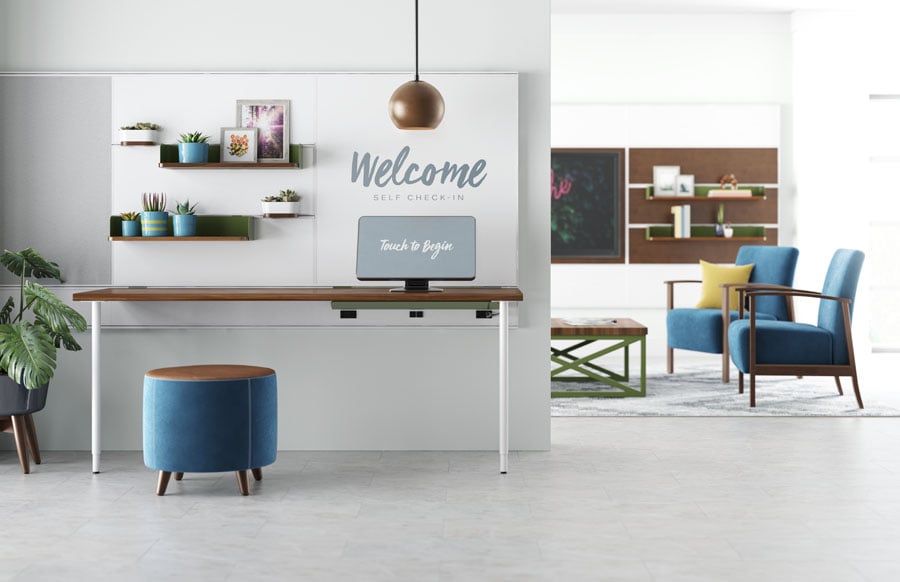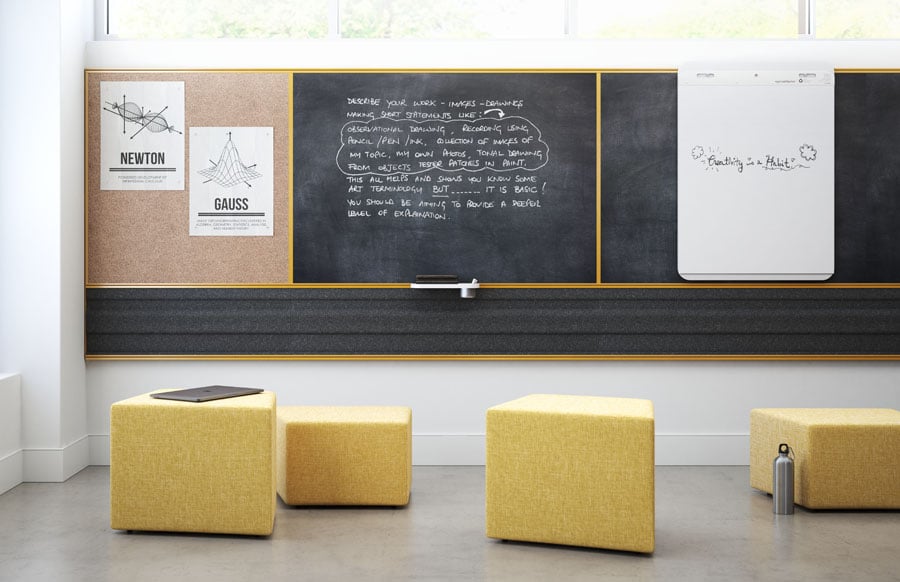
January 30, 2020
Putting Walls to Work
Work|Able from Kimball invites you to reimagine your empty walls.
Sponsored by:

People have seen wall space as an opportunity since the invention of the coat hook, but where some see ad hoc storage, Brian Graham sees a framework for the complete reorganization of space. The system he developed with American furniture maker Kimball is called Work|Able, and the idea behind it is quite a simple one: put the walls to work.
Work|Able is a modular system whose base is a series of horizontal rails mounted to the wall. Panels, shelving units, even desks and TV mounts are available in a range of sizes that slide onto the rails in a virtually unlimited variety of configurations.
The rails, says Graham, are a starting point. “If you look at this wall in elevation and somebody’s standing there, you’ve got these rails that come across and create these datum lines. If you’re sitting, if you’re standing, however you are, you’re relating to these horizontal lines.” Using Work|Able, it’s then easy to fill in space for a range of purposes, he explains. “Once you’ve figured out what the right heights are relative to a person and how they interact with it, the question you need to ask is: What makes sense in each of these zones that we’ve created between the rails?”

That’s where the options come in. With Work|Able’s plethora of surfaces, shelves, and other tools, the options to customize are virtually unlimited. When developing the system’s panels, Graham and Kimball made a breakthrough by adding additional depth between the wall and the surface. The rails are an inch and a half deep, giving enough space for such add-ons as a pegboard, an acoustical PET tile, corkboard, and chalkboard.
According to Graham, underutilized wall space is all around us, especially in workplaces. With Work|Able, he thinks, transitional and in-between spaces without a clearly defined purpose can be made to do more. “I’m really intrigued by this idea of being able to make that wall a sponsor for a place where you could run into somebody, you could do a huddle over on a table, or you could pin stuff up,” he says.
Graham explains that these types of underutilized or transitional spaces are often plagued by harsh acoustics. That’s where the acoustical PET tile that Kimball developed especially for this system comes in. With aesthetic and sound-dampening ridges, the tiles are a subtle textural addition that helps control noise as well in an office as it does in a hallway.
[videoembed]
[/videoembed]
But not all of Work|Able’s pieces are proprietary, in fact one of the features Graham is most excited about is a simple one-inch-by-one-inch pegboard, of the kind found in hardware stores, garages, and workshops the world over. “Pegboard,” he says, “is in your dad’s garage, it’s in my dad’s garage. It’s intuitive. You don’t even need an instruction booklet to use it. As a designer, you want to design everything, but sometimes, you have to acknowledge that something’s really, really good and you should just get out of its way.”
Work|Able is a system for bringing a wide range of components together on the wall, but it’s more than the sum of its parts. It’s a tool for reorganizing the space of a room and adding dynamic elements to any wall. Because the system is useable nearly anywhere, the aesthetics needed to be on the quieter side and able to blend in at any kind of workplace. “The system itself is supportive of the creativity and the aesthetic range of expression that a designer wants to bring to it,” he tells Metropolis making the case that Work|Able is more than a product, it’s a tool.












